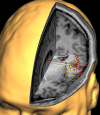Multiple somatotopic representations of heat and mechanical pain in the operculo-insular cortex: a high-resolution fMRI study
- PMID: 20739597
- PMCID: PMC2997041
- DOI: 10.1152/jn.00253.2010
Multiple somatotopic representations of heat and mechanical pain in the operculo-insular cortex: a high-resolution fMRI study
Abstract
Whereas studies of somatotopic representation of touch have been useful to distinguish multiple somatosensory areas within primary (SI) and secondary (SII) somatosensory cortex regions, no such analysis exists for the representation of pain across nociceptive modalities. Here we investigated somatotopy in the operculo-insular cortex with noxious heat and pinprick stimuli in 11 healthy subjects using high-resolution (2 × 2 × 4 mm) 3T functional magnetic resonance imaging (fMRI). Heat stimuli (delivered using a laser) and pinprick stimuli (delivered using a punctate probe) were directed to the dorsum of the right hand and foot in a balanced design. Locations of the peak fMRI responses were compared between stimulation sites (hand vs. foot) and modalities (heat vs. pinprick) within four bilateral regions of interest: anterior and posterior insula and frontal and parietal operculum. Importantly, all analyses were performed on individual, non-normalized fMRI images. For heat stimuli, we found hand-foot somatotopy in the contralateral anterior and posterior insula [hand, 9 ± 10 (SD) mm anterior to foot, P < 0.05] and in the contralateral parietal operculum (SII; hand, 7 ± 10 mm lateral to foot, P < 0.05). For pinprick stimuli, we also found somatotopy in the contralateral posterior insula (hand, 9 ± 10 mm anterior to foot, P < 0.05). Furthermore, the response to heat stimulation of the hand was 11 ± 12 mm anterior to the response to pinprick stimulation of the hand in the contralateral (left) anterior insula (P < 0.05). These results indicate the existence of multiple somatotopic representations for pain within the operculo-insular region in humans, possibly reflecting its importance as a sensory-integration site that directs emotional responses and behavior appropriately depending on the body site being injured.
Figures






References
-
- Afif A, Hoffmann D, Becq G, Guenot M, Magnin M, Mertens P. MRI-based definition of a stereotactic two-dimensional template of the human insula. Stereotact Funct Neurosurg 87: 385–394, 2009 - PubMed
-
- Afif A, Hoffmann D, Minotti L, Benabid AL, Kahane P. Middle short gyrus of the insula implicated in pain processing. Pain 138: 546–555, 2008 - PubMed
-
- Andersson JLR, Lilja A, Hartvig P, Långström B, Gordh T, Handwerker H, Torebjörk E. Somatotopic organization along the central sulcus, for pain localization in humans, as revealed by positron emission tomography. Exp Brain Res 117: 192–199, 1997 - PubMed
-
- Apkarian AV, Bushnell C, Treede RD, Zubieta JK. Human brain mechanisms of pain perception and regulation in health and disease. Eur J Pain 9: 463–484, 2005 - PubMed
Publication types
MeSH terms
Grants and funding
LinkOut - more resources
Full Text Sources
Medical

